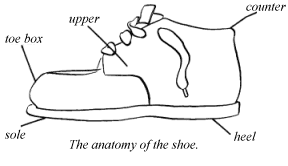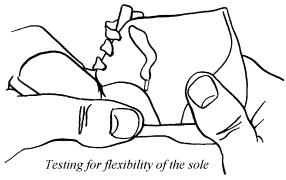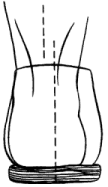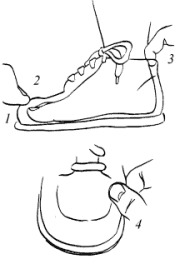
|
|||||||
Selecting Shoes for Children

Shoes are a necessary evil. If the whole world were all soft earth covered with a carpet of grass and leaves, there would be no need for shoes. However, since the modern-day world in which we live is, in large part, paved with hard, unforgiving concrete and littered with sharp remnants of glass and the like, the foot needs protection from injury. Although the adult shoe has changed from being a protective covering to becoming a status symbol, the child’s shoe has remained in its basic role - protecting the foot from the hazards of the outside world.
However, there is a great deal of confusion regarding the choice of appropriate shoes for children with normal feet. A recent survey of professionals who give advice on children’s feet (pediatricians, orthopedic surgeons, pediatric orthopedists, podiatrists) revealed wide divergence of opinion regarding shoes and footwear in both normal and problem feet. Not only is there difference in opinion between each group of practitioners, but marked differences occur among members of the same group. Of all the practitioners surveyed, 15 percent thought that, in general, high-topped "orthopedic" shoes contributed to normal foot development; 85 percent disagreed. In the same survey, 44 percent recommended soft shoes for infants, 32 percent recommended high-topped shoes, and 24 percent tennis shoes. What is a parent to do? I feel that the only rational approach to the subject is to examine some "traditional" ideas in the light of recent studies and experience and determine if they should be upheld or discarded.
- "Shoes are necessary to promote foot development."
In other words, normal children’s feet need support, otherwise they
will become flat. Recent studies seem to contradict this. Feet deformities,
like bunions and hammer toes are very rare among primitive people who
wear no shoes, in contrast to advanced cultures, where such deformities
are commonly seen. A study in England revealed that among children two
to four years of age, 80 percent of those who constantly wore shoes
had deflection of the terminal phalanx of the great toe, and 30 percent
had incurving of the fourth and fifth toes. These deformities were not
found in children who had not worn shoes.
Perhaps the most conclusive study was the one that compared foot forms among the non-shoe and the shoe-wearing Chinese population in Hong Kong. The incidence of hallux valgus, hallux rigidus, incurved fifth toe, hammertoe, and a host of other foot and toe deformities was much higher in the shoe-wearing population. The study concluded that the foot in its natural unrestricted form is mobile and flexible and free of the structural problems so often encountered in the shoe-wearing population. These observations ad one to conclude that shoes are not necessary for normal foot development A normal foot does not need shoe support. In contrast, heavy shoes, unless prescribed for a specific problem, do more harm than good.
- "High-top shoes are necessary to support the ankle as the
child takes his first steps." This myth is often perpetrated
by well-meaning but misinformed relatives. Studies have shown that when
a child is strong enough to stand up and walk, he will have ankles strong
enough to support his body. If he is not ready to walk, propping him
up with high-top shoes is not only ineffective, but probably detrimental
to his feet. Parents may still want to put their toddler in high-top
shoes. They should use them to prevent the child from kicking off his
shoes rather than in the mistaken belief that somehow the shoes support
his ankles.
- "Sneakers, if worn for more than a couple of hours a day,
are bad for children." This is a widely held belief among lay
people as well as professionals. There is absolutely no evidence that
normal feet develop into flatfeet if tennis shoes rather than high-top
or leather shoes are used. Dr. E. Bleck of Stanford University followed
forty children with normal feet over a period of ten years. These children
wore sneakers and nothing else. He found no tendency at all toward flatfeet.
Granted, not all sneakers are created equal. But a good pair of sneakers should not cause any foot problems if used appropriately.
- "A high arch is important for normal foot function."
Parents frequently come into the office complaining that their child’s
feet are flat A close examination indicates that although the feet have
low arches, they are by no means flat. Children with apparent flatfeet
(or low arches), when followed over long periods of time, do not develop
functional problems.
A classic study done by a famous orthopedic surgeon in Toronto some years ago on Canadian army recruits revealed that 22 percent of the recruits had the appearance of flatfeet, but were actually low arches They were all asymptomatic with no problems whatsoever,
- "Shoe salesmen are competent to diagnose foot problems and
advise remedial shoe wear for children." This is totally erroneous.
Most shoe salesmen are well intentioned and desire to sell you the most
comfortable shoes they can find. But they are not trained to give advice
regarding foot problems. The responsible salesman may suggest to the
parent that the child’s feet do not appear right and he would recommend
that the child be seen by a doctor; but the salesman certainly will
not suggest any kind of corrective shoes without a doctor’s prescription.
Remember, too, the salesman is there to make a sale. He is there to
help you choose the most appropriate pair of shoes possible, but the
responsibility of selecting the proper shoes for your child lies with
you the parent.
A recent survey of parents revealed that they most often obtain information about shoes from friends, relatives, and shoe salesmen. Only a minority talk to their pediatricians about their children’s shoes. An interesting finding of the study was that the parents who got advice from their physicians spent the least on shoes while the parents who got most of their information from salesmen spent the most for shoes. Shoe salesmen tend to recommend shoes with hard soles, high tops, laces and steel shanks. These are not only costly, they are also unnecessary and possibly harmful for some children. I do not want you to view the shoe salesman in an adversarial position. He knows the variety of shoes he has in stock and can advise you as to what is available when you tell him the features you are looking for. The following guidelines will help you know how to select shoes for your child.
The Age for Shoes
Now that you know shoes are unnecessary for foot support and development,
it is only logical to conclude that, for normal feet shoes serve only
one function: protection. In the first year of life before the child begins
to walk he does not need shoes. If the pre-walker has shoes on constantly,
he is deprived of the normal sensory stimulation his feet would otherwise
get from contact with the environment. Moreover, the small muscles of
his feet and toes do not get much chance for exercise and tend to under-develop.
Even the toddler does not generally need shoes when he is in the safe
environs of his home or backyard. Only for going out on the street is
a pair of sneakers necessary for protection.
The Price of Shoes
The price of shoes is often related to the kind of material used. Leather
is the most expensive, especially if it is used for both uppers and soles.
Since leather allows the feet to "breathe" in the shoes it helps
avoid sweat accumulation and skin irritation. While leather uppers are
desirable, leather soles are not necessary. Buying shoes with leather
uppers and rubber or crepe soles will cut down on the price considerably.
It is not necessary to get the most durable or expensive children’s shoes.
The chief reason for replacing shoes is that children outgrow them. High
quality, long lasting shoes are therefore an unnecessary expense. Sneakers
are much less expensive. They have cloth or canvas uppers and, like leather,
allow the feet to "breathe" . The exception are running shoes
with rubber bindings which tend to cause sweat accumulation if worn for
long periods of time. The rubber bindings however, make the shoes more
water-proof—a distinct advantage on wet days. On the whole, sneakers that
have the desired qualities that we shall discuss serve just as well as
the more expensive leather shoes.
I advise a pair of good sneakers or running shoes for everyday wear for most children. Even then, they should be allowed to be without shoes for part of the day. Young children feel as much with their feet as with their hands and sensory input is essential for brain development. Moreover, exposing the feet allows for ventilation and prevents sweat buildup and skin problems.

The Soles of Shoes
The soles of the shoes whether leather or rubber, should be thick enough
to protect, yet flexible enough for walking It is also important to look
at the bottom of the soles to determinethe depth of the grooves The deeper
the grooves the better the traction. These kinds of shoes can he used
in wet weather and even wintertime with no slippage problems.
Flexibility in the sole is very important. The normal foot flexes at the metatarso-phalangeal joints moving through a range of 30 to 40 degrees during normal walking. A good shoe should allow this. Sneakers are admirably suited in this respect. Rigid soles, unless prescribed by a physician for a specific problem, should be avoided. The way to test flexibility is by bending the shoe upward. The sole should bend in the ball area without much effort on your part.
 Fig:
Right heel in shoe. The slight offset between the axis of the leg and the
axis of the shoe puts stress on the shoe counter, hence the need for a firm
and substantial shoe counter.
Fig:
Right heel in shoe. The slight offset between the axis of the leg and the
axis of the shoe puts stress on the shoe counter, hence the need for a firm
and substantial shoe counter.
The Shoe Counter
If you look at the back of your child’s feet while he is standing
you will notice that the heel cords (tendo-Achilles) deviate slightly
outward away from each other as you follow them down to the heels.
A firm, substantial shoe counter is necessary to prevent the counter from becoming deformed. If it is flimsy, the slight offset of the heel cord and ankle will cause the counter to deviate inward and the hindfoot will not sit squarely on the shoe as it should.
Children tend to abuse their shoes. How many times have you seen your child run out to play while his shoes are only half on and the heel of the foot is still on the shoe counter, squashing it in the process? A flimsy shoe counter will not be able to withstand this abuse. It will lose its support very quickly.
A padded counter is also important. Run your finger along the inside of the shoe counter. Check to see if there is anything hard or irregular that could cause irritation to the back of the child’s heel.
The Heels on Shoes
Children’s shoes should not have heels. Heels encourage the child to walk
on his toes, and this causes tightening of the heel cords. High heels
should definitely be avoided. Most leather shoes have a slight heel. If
worn occasionally, this does not matter. But sneakers or running shoes
are ideal in this regard.
Fitting Children’s Shoes
You must remember that you are looking for a pair of shoes to fit your
child’s feet, not vice versa. To get a good fit, both the shape and the
size of the shoes should conform to his feet. No two feet are identical
in all respects Unless shoes are custom-made there is no such thing as
the "perfect fit" For perfect fit you not only have to get shoes
of adequate overall length and width, but they also have to satisfy other
considerations. The widest part of the foot may not be seated in the corresponding
widest part of the shoe, even though they may be of the same width. Also,
the width of the heel may not fit the heel of the shoe. However, this
does not mean that one cannot find shoes that are comfortable and that
generally conform to the shape and size of the foot.
Foot size increases with standing as well as with the time of day. Feet are slightly longer and wider at the end of the day. The average adult foot increases 4 percent in volume from morning to night. This translates to an increase of foot width of up to one-half inch (or two sizes) and length of up to one-eighth inch (or one-half size). While no formal study has been done in children, I believe that proportionate increases could be expected. I would therefore recommend that you shop for shoes later in the day when feet are at their largest.
Even while you are looking at the different shoes in the store, keep in mind the shape of the shoe that you should be looking for. The shape of the shoe is determined by the last which is the model from which the shoe is made. You want a straight last since this conforms best to the shape of your child’s foot. Most shoes for preschool children are made from straight lasts Unfortunately, due to the dictates of fashion and profitability, many lasts for older children have been flared inward. If you imagine the shoe like the foot consisting of a back part and a forepart, the forepart is angled inward. Such a shoe would force the foot into an adducted or in-toe position, much like metatarsus adductus. In addition, some shoe manufacturers have stylized the toe box, making it more pointed. This squeezes the toes together in an unnatural position and is a frequent cause of bunions and other toe deformities in children. The way to determine flare is not by looking at the bottom of the shoes; the undercut of the shank area and the trimmings of the outsole may be deceptive. The way to determine flare is to look at the shoes from above. Visually gauge the shape of the shoe as a whole to determine if the forepart flares inward. Also determine at the same time if the toe box has been stylized and pointed.

When you have decided on a few styles which are acceptable to you on the basis of the last, you are ready for the salesman. Always have the salesman measure your child’s feet, rather than just telling him what size you think is right. When being measured, the child should be standing up and putting full weight on his feet. If there is a size difference between the feet take the larger size.
There is nothing magical about the measurements. They are not necessarily the right size for your child. The measurements only give you a place to start. Once the shoes are on, they should be checked for adequate length and width. With the child standing check the toe box to make sure the toes have plenty of room. You should be able to feel a thumb’s space between the end of the toes and the tip of the shoe. For adequate width, check the broadest part of the foot which is at the ball of the foot. Feel the shoe. It should not be bulging out, indicating tightness and you should be able to get a pinch of leather or canvas. With the child standing, see if there is enough room behind his heel to insert your little finger. This ensures that the shoe has enough growing room in the back. Remember that the foot grows backward as well as forward.
 Shoe fitting: (1) toe box is rounded and roomy, not pointed;
(2) thumb space between the ends of the toes and the tip of the shoe; (3)
tip of little finger between the heel and counter at the back; (4) pinch
of leather or canvas at the widest part of the shoe.
Shoe fitting: (1) toe box is rounded and roomy, not pointed;
(2) thumb space between the ends of the toes and the tip of the shoe; (3)
tip of little finger between the heel and counter at the back; (4) pinch
of leather or canvas at the widest part of the shoe. Have the child wear the shoes and walk around the store for about five minutes Then quickly remove the shoes and examine his feet for any redness. Check especially the little toes, the widest part of the foot at the base of the great toe, and the back of the heels. Redness is an indication of pressure on these areas Do not accept discomfort as a normal "breaking in" process. Feet could break in the process!
A child may be stoical about discomfort and not complain even if shoes are too tight or constrictive. But if he tends to remove his shoes frequently, limps or refuses to walk whenever he is in shoes, take note and suspect misfit. Keep in mind, too, that children’s feet have a way of growing out of their shoes.
Frequency of Size Change
The most common reason for replacing children’s shoes is that they
have been outgrown. Some people in the shoe industry have recommended
that shoe size should be changed every two months for children between
the ages of two and six. While this is great for the shoe industry, it
is prohibitively expensive, This recommendation is not based on any longitudinal
study of children’s foot growth.
Fortunately for parents, more recent studies by the medical profession have revealed that while children’s foot growth is rapid, changes in shoe size need not be that frequent. Between the ages of twelve and thirty months foot growth is explosive, and, indeed, size change should be considered every three months. However, from three to six years of age, the foot grows much less rapidly and one needs to check for size change only once every four to six months. Every child’s growth is different, and one should not be negligent in replacing outgrown shoes. Habitual use of out-grown shoes can cause foot and toe deformities, not to mention the discomfort inflicted on the child.
Handing Down Shoes
The shoe industry frowns on handing down shoes. The feeling is that the
old shoes bear the imprint of the previous owner’s feet, and may cause
problems for the new owner. While this may be true in some cases it is
not the rule. Needless to say, handing down shoes should be practiced
only within the family. Never wear shoes that belonged to strangers since
shoes can be a source of disease transmission.
The wise parent likes to save money whenever she can, but not at the expense of foot health. She will examine the old shoes to make sure they are in good condition before handing them down to the next child. She will not hand shoes down if:
- The previous owner had feet problems like true flatfeet or metatarsus adductus.
- The heels or soles of the shoes are unevenly worn. This usually indicates feet problems in the previous owner.
- The counter of the shoe is deformed or badly creased from previous abuse.
- The uppers of the shoes, especially at the toe box, have been stretched out or are bulging, indicating previous misfit. Put your hand into the shoes and feel for any grooves from excessive wear. If any are present, it is best not to reuse the shoes.
If, after carefully examining the shoes, you find them in good condition, there is no reason why you should not save yourself some unnecessary expenses.
NOTICE: The information presented is for your information only, and not a substitute for the medical advice of a qualified physician. Neither the author nor the publisher will be responsible for any harm or injury resulting from interpretations of the materials in this article.
Questions
or comments? Post your thoughts in the Orthoseek
Message Forum!
Find a pediatric orthopedic surgeon
in an area near you.
Home | About Us | Orthopaedic Topics | Message Forum
![]()
Comments, questions, or suggestions are welcome. Please
contact us using this form.